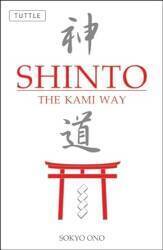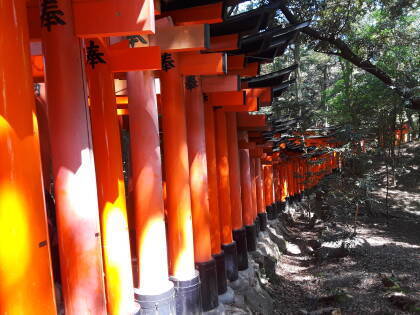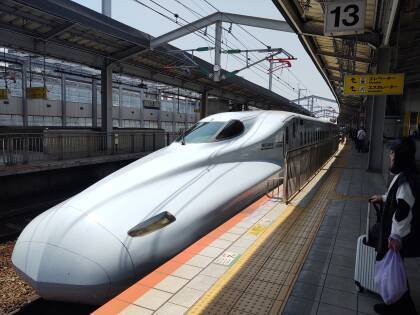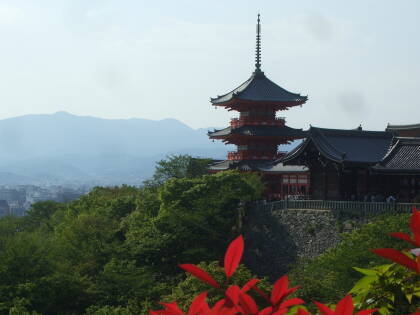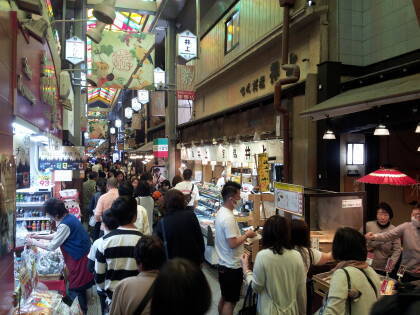
1,000 Gates at Fushimi Inari-taisha
Fushimi Inari-taisha
Shintō and Buddhism in Japan
Fushimi Inari-taisha
is the head shrine of the Shintō kami
or deity Inari.
Inari is best known as the kami of rice,
but Inari is also worshipped as the patron deity of business.
The torii or vermillion gates lining the paths
have been donated by businesses.
Inari is also the kami of foxes,
who are often represented as guardians of shrines.
Inari's pure white messenger foxes, or kitsune,
act as the deity's messengers.
The deity Inari is represented as an old man carrying rice,
as a young female food goddess, as an androgynous
bodhisattva borrowed from Buddhist imagery,
or as a combination of three or five kami.
Good luck selecting a useful pronoun,
there's a reason that Inari is always referred to by name.
Over 32,000 Shintō shrines, over one-third of
the total in Japan, are dedicated to Inari.

Arrival
K's House atBooking.com
I was staying at K's House in Kyōto. It's just a short walk from Kyōto Station and several sights. And, you can get a big breakfast (and practice your katakana and hiragana) before setting out for a busy day.
I walked just a few blocks east and across the river to the Shichijō Station on the Keihan Main Line. My trusty Suica transport card, which I bought on arrival at Tōkyō's Haneda Airport, worked here the same as it does throughout Japan on subways and local trains.
I rode just three stations south to the Fushimi-Inari Station. From there it's just a few blocks east, past the JR Inari Station and across a small river, to the shrine entrance. Electrical details are clearly visible in Japan.

Vendors line the way from the closer train station to the shrine entrance.
They get a lot of business. Several million worshippers visit during the Japanese New Year season.


A large torii or gate marks the entrance to the shrine grounds. Torii mark boundaries where you cross into increasingly sacred space. The large main gate is visible through the center of the torii, but first we'll stop at the lower structure in front of it.

Shintō shrines and Buddhist temples have ablutions fountains where you clean yourself before entering. It's the same concepts, you do it the same way, but Shintō and Buddhism use different terminology. In Shintō the purification rite is temizu, the water reservoir is chōzubachi, and the shelter is chōzuya or temizuya. Let's get clean! To do this properly:
- Pick up the dipper with your right hand, filling it from where water is pouring in or dipping water out of the reservoir.
- Pour the water over the fingers of your left hand, being careful to make sure that the water falls into the gutter around the reservoir.
- Transfer the dipper to your left hand, get more water if you need it, and pour water over the fingers of your right hand.
- Transfer the dipper back to your right hand, again getting more water as needed, and pour water into your cupped left hand.
- Take water out of your cupped left hand into your mouth, swish it around, then spit it into the gutter around the reservoir.
- Raise the dipper up so that the remaining water runs down over the handle and your right hand, falling into the gutter, and return the dipper to the fountain.

Earlier structures for this shrine were built in 711 in southwestern Kyōto. But in 816 the shrine was re-located at the request of the monk Kūkai, who had founded the Koyasan mountaintop complex of Buddhist monasteries and temples. The main complex here was built in 1499.

The main gate or rōmon, the "tower gate", is flanked by guardian fox statues. Notice that each holds a key in its mouth. This represents Inari's key to the granery.

The central passage through the gate is flanked by large niches holding statues. These are typically Niō, Hindu deities who have been incorporated as protectors against evil spirits. Their fierce appearance keeps demons and thieves out of the temple grounds. Here, they're samurai.
Typically, the figure on the left has an open mouth, pronouncing the sound of the Sanskrit letter अ or A, while the figure on the right has a closed mouth, pronouncing the sound of the Sanskrit latter म or MA. Together they pronounce the sacred syllable Aum or ॐ. Yes, it's very syncretic, pieces of Hinduism, Buddhism, and Shintō.


There are multiple pavilions within the lower shrine complex.


The honden or shinden or shōden is the most sacred structure at a Shintō shrine. It is strictly for the use of the enshrined kami (or spirit), which is usually symbolized by a mirror, or sometimes by a statue.
Many Shintō shrines hide the main object representing the kami. Fushimi Inari-Taisha, however, like most Inari shrines, has the main object visible. It's a mirror, as usual.
The honden of a shrine is usually at the rear, inaccessible by the general public. In front of the honden is usually the haiden or oratory. In a more elaborate shrine, a heiden or hall of offerings may connect the haiden to the honden.
A rite is underway in the haiden of the main shrine down here at the lower complex at the entrance.
This shrine gets so many visitors that it has multiple ropes and bells. Usually there's just a single rope and bell at the center. Visitors shake the rope to rattle the bell and get the attention of the kami.

This shrine came under Imperial patronage during the early Heian period. Emperor Murakami decreed in 965 that messengers were to carry written accounts of important events to the guardian kami of Japan. This started with 16 shrines, including this one.
When the Emperor took overall control at the Meiji Restoration in the late 1860s, he soon officially designated this shrine as one of the first rank of government-supported shrines.
That ranking held until 1946. The Meiji Restoration had led to a greatly increased cult of the divine Emperor. That in turn led to Japan's nationally suicidal attitude during World War II. If everyone had to die to preserve the office of the Emperor, so be it. The Allies had spoken of "State Shintō". While the Japanese people hadn't used that term, the concept was dialed way back.
Starting up the First Path
The inner shrine or okumiya is part-way up the mountain. Tens of thousands of small shrines and altars line the path to the peak.
The railway station is at about 20 meters elevation at most. The peak is at 233 meters elevation. We have a little over 200 meters to ascend, let's get started.
There's one more multi-bell shrine before we pass through the torii leading to the lower path.


OK, just one more picture in the rented kimono. Then we'll start climbing.
Fushimi Inari-Taisha is known for having over 1,000 torii. They were donated by businesses, as Inari is also a patron deity of merchants.

Looking forward, many sections look like you're moving through a vermillion tunnel.



Turn and look backward to see the business inscriptions.


You don't have to go very far at all to reach the first shrine along the way. The heavy rope and folded paper are standard symbols.
Meoto Iwa, the "Wedded Rocks" at IseThe rope, made from rice straw or hemp, is shimenawa. It's believed to ward off evil spirits. It's also placed around yorishiro, objects that can attract spirits, and where spirits may dwell.
The zigzag paper streamers are shide. They're used in blessing and purification rituals.


The Main Path
Some people turn back here. You've passed through maybe 200 meters of torii tunnel, and seen multiple shrines. But we'll keep going. There are about 4 kilometers of paths.







The path emerges into a small open area part-way up. We've been in the forest, we lose track of how large and close the city of Kyōto is.
Okumiya, the inner shrine
The inner shrine complex has many shrines and altars.







Climbing Further
We continue toward the peak.






At The Peak
We've reached the pack, at 233 meters elevation.







Returning to Kyōto
Now we have a long descent to return to the railway station and return to Kyōto. Where next?
Choose your next stop around Kyōto:
Or, somewhere else around Japan:

